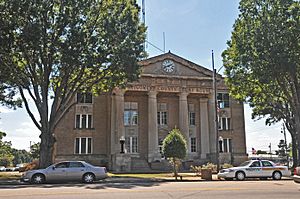Troy, North Carolina facts for kids
Quick facts for kids
Troy, North Carolina
|
||
|---|---|---|

Montgomery County Courthouse
|
||
|
||
| Motto(s):
"Gateway to the Uwharries"
|
||

Location of Troy, North Carolina.
|
||
| Country | United States | |
| State | North Carolina | |
| County | Montgomery | |
| Area | ||
| • Total | 3.70 sq mi (9.59 km2) | |
| • Land | 3.66 sq mi (9.48 km2) | |
| • Water | 0.04 sq mi (0.11 km2) | |
| Elevation | 623 ft (190 m) | |
| Population
(2020)
|
||
| • Total | 2,850 | |
| • Density | 778.69/sq mi (300.68/km2) | |
| Time zone | UTC-5 (Eastern (EST)) | |
| • Summer (DST) | UTC-4 (EDT) | |
| ZIP code |
27371
|
|
| Area codes | 910, 472 | |
| FIPS code | 37-68520 | |
| GNIS feature ID | 2406760 | |
Troy is a town in Montgomery County, North Carolina, USA. In 2010, about 3,188 people lived there. It is the main town, or county seat, of Montgomery County. A story called The Sheriff's Children by Charles W. Chesnutt takes place in Troy.
Contents
History of Troy
Troy is in an area that used to have many tall pine trees. The town grew because people cut down these trees for wood and turpentine. At first, the area was called West Old Fields. In 1843, its name changed to Troy. This happened when the main county office moved there from Old Lawrenceville. Troy officially became a town in 1853.
The town grew faster in the late 1800s. This was thanks to the new Asheboro and Aberdeen railroad. Also, gold mining nearby helped the town's economy. By the 1900s, factories making cloth and wood products were very important to Troy.
Some old buildings in Troy are famous. The Hotel Troy, the Montgomery County Courthouse, and the Troy Residential Historic District are special. They are listed on the National Register of Historic Places.
Geography and Location
Troy is a town in North Carolina. It covers about 3.0 square miles (7.8 square kilometers). Most of this area is land, with a small part being water.
Troy is located within the Uwharrie National Forest. This forest covers a large part of Montgomery County.
People of Troy
The number of people living in Troy has changed over the years. Here is how the population has grown:
| Historical population | |||
|---|---|---|---|
| Census | Pop. | %± | |
| 1870 | 67 | — | |
| 1880 | 130 | 94.0% | |
| 1900 | 878 | — | |
| 1910 | 1,055 | 20.2% | |
| 1920 | 1,102 | 4.5% | |
| 1930 | 1,522 | 38.1% | |
| 1940 | 1,861 | 22.3% | |
| 1950 | 2,213 | 18.9% | |
| 1960 | 2,346 | 6.0% | |
| 1970 | 2,429 | 3.5% | |
| 1980 | 2,702 | 11.2% | |
| 1990 | 3,404 | 26.0% | |
| 2000 | 3,430 | 0.8% | |
| 2010 | 3,189 | −7.0% | |
| 2020 | 2,850 | −10.6% | |
| U.S. Decennial Census | |||
Troy's Population in 2020
In 2020, there were 2,850 people living in Troy. These people lived in 1,099 homes. About 547 of these were families.
| Group | Number of People | Percentage |
|---|---|---|
| White (not Hispanic) | 1,375 | 48.25% |
| Black or African American (not Hispanic) | 939 | 32.95% |
| Native American | 11 | 0.39% |
| Asian | 37 | 1.3% |
| Other/Mixed | 67 | 2.35% |
| Hispanic or Latino | 421 | 14.77% |
Troy's Population in 2010
In 2010, Troy had 3,189 people. There were 1,115 homes and 704 families. The town had 1,209 housing units.
The people in Troy came from different backgrounds:
- 58.9% were White.
- 31.8% were African American.
- 0.73% were Native American.
- 1.0% were Asian.
- 3.32% were from other races.
- 1.5% were from two or more races.
- About 10.3% of the people were Hispanic or Latino.
In 2010, about 30.3% of homes had children under 18. About 37.2% were married couples. Around 20.4% of homes had a female head without a husband. About 34.6% of homes were single people. About 16.0% of homes had someone 65 or older living alone.
The average age in Troy was 36.7 years. About 21.6% of people were under 18. About 15.4% were 65 or older.
Education in Troy
Troy has several schools and colleges for students.
- Montgomery Community College
- Montgomery County Central High School
- Montgomery Learning Academy
- Page Street Elementary
Notable Person from Troy
- Henry F. Warner was a soldier in the United States Army. He received the Medal of Honor. This was for his brave actions in World War II.
Images for kids
See also
 In Spanish: Troy (Carolina del Norte) para niños
In Spanish: Troy (Carolina del Norte) para niños





